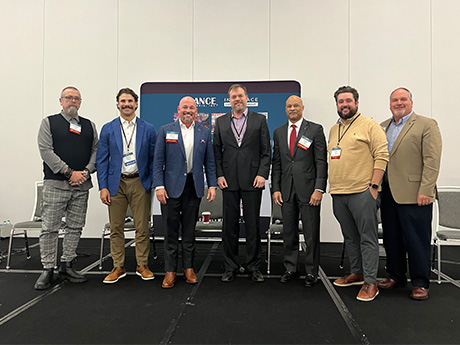ATLANTA — Interest rates. Tariffs. Natural disasters. These three factors alone frighten any developer, let alone those who are tasked with delivering our nation’s affordable housing supply.
Just to get to the ribbon-cutting ceremony, developers have an uphill climb. They have to obtain the land outright or in a ground lease agreement, navigate the permitting and entitlement processes, overcome any neighborhood pushback, raise equity and borrow the necessary capital and then build these communities on time and on budget.
Editor’s note: InterFace Conference Group, a division of France Media Inc., produces networking and educational conferences for commercial real estate executives. To sign up for email announcements about specific events, visit www.interfaceconferencegroup.com/subscribe.
“We try to stay in control of what we’re in control of,” said Christopher Byrd, Southeast region development director of LDG Development, an affordable housing developer based in Louisville, Ky. “As long as we are in the right markets with the right growth and the right partners, we are safe and insulated.”
Byrd’s comments came while on stage during the development panel at InterFace Affordable Housing Southeast, a networking and information conference held at the Cobb Galleria Centre in Atlanta on Tuesday, May 7. Kelly Williams, vice president of business development at Impact Housing Group, moderated the discussion.
Tyler Epps, senior vice president of American South Capital Partners, summarized the discussion by saying that his main takeaway from the panel and the entire conference — which included panels on capital markets, investment sales and design/construction — was the topic of uncertainty, whether that be tariffs or the announced workforce slashes to the U.S. Department of Housing and Urban Development (HUD).
“The overarching theme from today is uncertainty and how it’s being priced in,” said Epps. “We are underwriting anywhere from 2 to 10 percent increases on total costs, not just material costs.”
Epps shared an anecdote about an $86 million development that had to be scrapped because of the uncertainty surrounding tariffs. The project suffered from cost overruns due to delays on securing building materials and the increase in interest reserves from the lender.
The panelists said one thing that is squarely in developers’ control is education — namely educating municipalities, civic organizations and neighborhood groups on the affordable housing product type.
“It’s up to us to take the time to go in and educate or let municipalities know which tools they have at their disposal,” said Byrd. “We’re trying to find ways to bring affordable housing to communities and keep rents affordable. It’s very challenging. Municipalities are looking for ways they can participate.”
James Talley, regional vice president at Mercy Housing Southeast, said his firm is also seeking to educate in the form of advocacy. He told the audience how important it is for affordable housing developers to relay the importance of the Low-Income Housing Tax Credit (LIHTC) program to state governments and how it should be expanded, not contracted.
“All we deal with is LIHTC, so we are beholden pretty much to the QAP in any given state,” said Talley, referring to qualified allocation plan, which dictates a state housing finance agency’s allotment of tax credits for the following one or two years.
The LIHTC program was created in 1986 and is governed by Section 42 of the Internal Revenue Code. Each state’s housing finance agency administers the program within its jurisdiction. LIHTC is a federal tax credit, so the holder of the credit receives a dollar-for-dollar reduction of their federal tax liability over the 10-year period when investors receive the tax credit payments.
“LIHTC is still the greatest tool to secure affordable housing and get it out of the ground,” said Byrd. “Equity is hard to find outside of LIHTC. Ninety percent of LDG’s pipeline is LIHTC.”
“The tax credit equity market is softening quite a bit,” added Jon Toppen, president of Tapestry Development Group. “A lot of the groups that would have happily made an offer are backing off. They’re being much more [selective] about what they do.”
Byrd also emphasized the importance of speed to market in terms of developing affordable housing. He told the audience a story about two very similar communities that LDG was developing around the same time but in different municipalities. One project received its certificate of occupancy (CO) in four months while the other didn’t receive its CO for 14 months.
“The entire life cycle of a development just needs to happen faster,” said Byrd. “We are starting to focus now more on the politics of the place. We are really trying to just understand the place and how we can get housing on the ground faster, because that’s what people are waiting for.”
Marcus Wiedower, vice president of Hillpointe, concurred. He added that being efficient is what led the firm to invest in an external affairs team to expedite any red tape that may arise during due diligence.
“We have to move fast and be efficient,” said Wiedower. “Things like traffic studies need to be done before we even walk in your door. We have built a spreadsheet of every regulation that we have run up against and we try to check every box, whether those [issues] actually come up or not.”
In addition to his role at Hillpointe, Wiedower is a member of the Georgia House of Representatives. He echoed what other panelists said about advocacy, but he emphasized that developers and other stakeholders need to understand who they’re speaking with ahead of time.
“Know what you’re reaching out about because you will lose credibility if you are reaching out to somebody at the state level and you’re talking about DOGE,” said Wiedower.
— John Nelson


